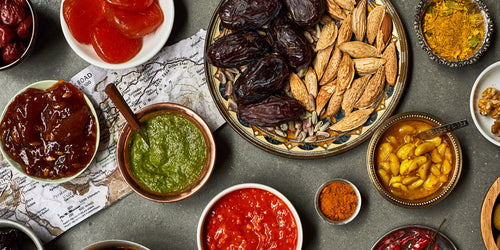Your Cart is Empty
Editor’s note: Hawa Hassan is the founder of Basbaas Sauce, a deliriously good line of organic chutneys inspired by the flavors of her native Somalia. Born in Mogadishu during the country’s civil war, her family fled to a UN refugee camp in Kenya before a sponsorship allowed Hassan to immigrate to Seattle at the age of seven. 15 years passed before she saw her family again, during which time she became a model and activist in New York. But reuniting with her mother, who’d since immigrated to Norway and become a small business owner, ignited Hassan’s passion for Somali cuisine and a desire to share it with a new audience of American cooks. We caught up with Hassan in her kitchen to talk about entrepreneurship, her new cookbook, and what makes a good pot of rice.
It wasn’t until I was in middle school that I realized no one else in my family was coming to America, and I should go make some friends and play basketball. Even then I was alone a lot as a kid, and while I’d cook to feed myself, cooking wasn’t a major interest until later in life. But making rice is like boiling water in Somalia. Everyone knows how to do it, so it’s hard to say when I first learned to make bariis.
Bariis is a Somali rice pilaf often served with stewed chicken or beef. I start by cooking red onions in oil with cinnamon sticks and cloves, then add tomatoes and a spice blend called xawaash, which everyone grinds themselves, but it usually has cardamom, cinnamon, and turmeric. Xawaash is like the garam masala of the country: it goes into pasta, tomato sauce, meat dishes, all sorts of things. It’s really the flavor of the Indian Ocean.

Later this year, my friend Julia Turshen and I are heading to East Africa to research a book we’re co-authoring, and the best way I can describe it is a book on the kitchens of nations that border the Indian Ocean. We’ll visit Somalia, Eritrea, Kenya, Tanzania, and a few more countries to meet, shop, and cook with bibis (grandmothers) and understand how these foods traveled and evolved from region to region. There’s so much history—Muslim and Christian influences, Indian ingredients, Italian foods like pasta—and it’s rarely talked about over here. Everybody is looking for ‘global flavors’ these days, but if you don’t understand the culture and the people, you won’t really understand how those flavors fit together.
A few years ago, I took four months off to stay with her in Norway, and of course we cooked together almost every day. She’s a true entrepreneur; she learned how to run a business from my dad, but she’s so much better at it. She runs a Somali goods store, a furniture store, and now owns a restaurant.

Building a food brand in America is incredibly difficult, but when I look at my mom and the problems she’s solved and the ways she’s reinvented herself, that puts it all into perspective. I can’t help but feel inspired.
Basbaas is the Somali word for ‘chile,’ so it felt like a fitting name for a company that makes the chutneys and sauces we eat with everything, like ketchup and hot sauce rolled into one. Before I left on that four-month trip to Oslo, I was thinking about starting a juice business, and I brought my Vitamix blender with me with the intention of testing recipes. My mom’s the one who convinced me that ship had sailed. So when we cooked together, I used the Vitamix to grind her chutney recipe, and she loved how smooth and creamy it turned out. The coconut chutney we sell through Basbaas is basically her recipe, but with a few modifications of mine for the American market. Since basbaas is always homemade, you can’t buy packaged versions anywhere in the US, so I feel a responsibility to produce one that’s true to Somali flavors but that will also inspire more Americans to understand Africa’s diverse cuisines.
Always rinse and soak your rice before making bariis, or really any rice dish. You want to get rid of that dusty coat of surface starch so your rice cooks into fluffy grains; as little as ten minutes of soaking makes a world of difference. Once the tomatoes and xawaash have combined with the onions into a jammy paste, I add rice and stir the grains until they’re coated with seasoned oil. Then I toss in some raisins—you see this a lot in Somali food, blending sweet and savory with spice—salt, and a bit of water so the rice starts simmering. Mushy rice is the worst, so I like to cook bariis in a pot without the lid, adding water and stirring as I go until the rice is cooked through.
I try to get to Norway as often as I can, both to catch up with my family and to recharge my Somali batteries. But when I’m stuck in New York, alone and working late, a pot of bariis helps bring me home.
Try Hawa's tamarind date sauce.
Recipe: Bariis (Somali Rice Pilaf)






